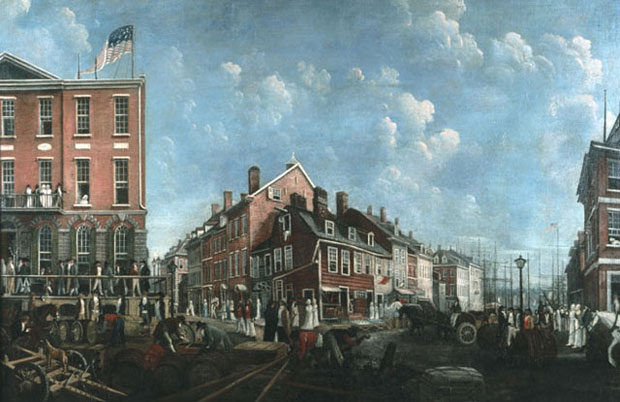Our next stop on the tour is South Street Seaport. New York was an incredibly important port city in North America and in the British Empire as a whole. Much business was done here both in intercontinental and international trade. In 1769 alone, New York “shipped thirty-four separate commodities to Britain, thirty-five to the West Indies, nineteen to the Mediterranean, and fifteen to Ireland.”[1] Many goods were shipped out of New York harbor to parts of the British Empire, but to other places as well. New York was part of a larger global trade pattern called the Triangle Trade which connected North America, Europe, and Africa. As such, slavery was still legal in New York, however, it is important to note that as New York became a safe haven for loyalists during British occupation, slaves who ran away from their owners at the promise of freedom from the British army came as well. Some merchants, additionally, made money off the war because the city was the main port of entry for soldiers and materials. There were approximately 240 merchants in New York in 1766, some of whom had accumulated great wealth, such as the DeLanceys and the Jaunceys.[2] Many of these wealthy families remained loyal to the crown and were hit particularly hard at the end of the war because of the Act of Attainder in 1779, which called individuals by name, confiscated their property and banished them from New York.[3]
In order to protest the acts imposed on them by the British government from the mid-1760s to the mid-1770s, members of New York society created non-importation agreements. These called for the use of goods and products made in the colonies as opposed to the motherland. There were consequences for those who did not follow these agreements. One such person was a jeweler from London, Thomas Richardson, who imported goods, and a contemporary broadside stated that “it was hoped that the Treatment some Capital Offenders met with, would have deterred the most obstinate and daring from attempting to imitate Examples so inglorious and dangerous.”[4] It is clear from this advertisement that those who violated the terms of non-importation were punished, and it is also clear that Richardson was not the first offender. His actions are seen as dangerous—as a threat to the cause. While the patriot and loyalist factions were not solidified at this point, as independence was not yet in their minds, there were many negative interactions between the soon-to-be opposing sides and relations soured as the war progressed. Today, visitors can go to a museum about the seaport and go by the river to try to imagine what this bustling port city would have been like during the period.
[1] Edward Countrymen, “The Uses of Capital in Revolutionary America: The Case of the New York Loyalist Merchants,” The William and Mary Quarterly 49, no. 1 (1992): 10.
[2] Ibid., 10.
[3] “Act of Attainder,” Provincial Archives of New Brunswick, October 22, 1779. Accessed October 25, 2016. http://archives.gnb.ca/exhibits/forthavoc/html/NY-Attainder.aspx?culture=en-CA.
[4] New York, September 18, 1769, Advertisement. Broadside 1769, 11381 (Early American Imprints Collection).
*Photo: Francis Guy, “Tontine Coffee House, Merchant’s Coffee House, and Wall Street, leading down to the East River,” oil on linen, 1797, https://commons.wikimedia.org/wiki/File:Tontine_coffee_house.jpg (accessed December 9, 2016).
![]()
